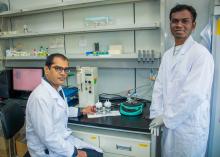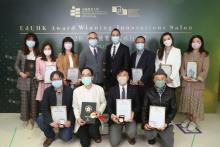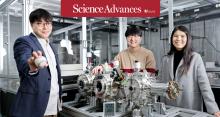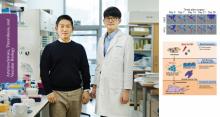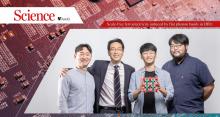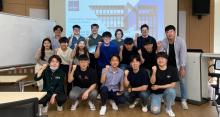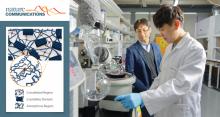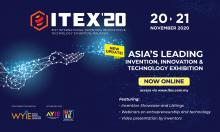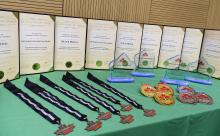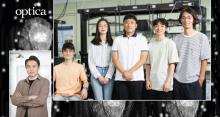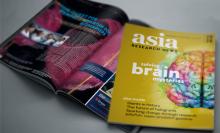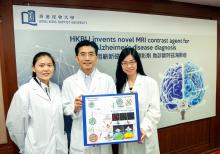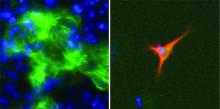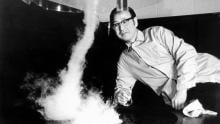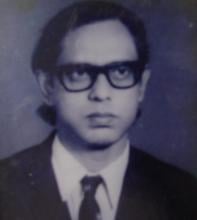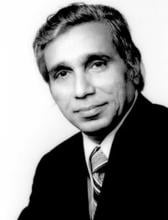Inventions
News
12 May 2021
Invented by Professor Ho Wing-kei at the Department of Science and Environmental Studies of The Education University of Hong Kong (EdUHK), the novel graphitic carbon nitride photocatalyst provides an innovative way for environmental purification. Compared to the traditional photocatalyst such as titanium dioxide, which can only be activated by UV light, and has a relatively low effectiveness in air pollutant degradation, the newly developed photocatalyst can utilise visible light (daylight or indoor light) as the light source for photocatalytic reactions.
13 Apr 2021
Scientists develop high performing electrocatalyst to synthesize ammonia in an effort to replace conventional eco-unfriendly methods
24 Mar 2021
With the aim of promoting knowledge transfer, The Education University of Hong Kong (EdUHK) hosted the Award-Winning Innovations Salon (AWIS) to showcase its award-winning projects recognised in international invention and innovation competitions in 2020. During the past year, the University won 22 international awards.
19 Feb 2021
Undergraduate students explore a more efficient way to measure protein-containing vessels released by cells
19 Jan 2021
New ‘armoured’ T cells attack cancer without being suppressed by drugs given to transplant patients to avoid organ rejection.
20 Nov 2020
A research team, affiliated with South Korea's Ulsan National Institute of Science and Technology (UNIST) has unveiled a new eco-friendly and low-cost method to synthesize indolopyran, one type of nitrogen ring compound, contained in about 60% of drugs that are recently approved by FDA.
20 Nov 2020
A research team, affiliated with South Korea's Ulsan National Institute of Science and Technology (UNIST) has proposed a new experimental approach for estimating the H‐bond free energy of local biological water.
19 Nov 2020
A recent study, affiliated with South Korea's Ulsan National Institute of Science and Technology (UNIST) has unveiled a highly-flexible and durable electrode using the dream material, graphene.
19 Nov 2020
A recent study, affiliated with South Korea's Ulsan National Institute of Science and Technology (UNIST) has unveiled a new technique that gives an enhanced hydrogen production yield by 5 times via the deposition of highly porous superaerophobichydrogels on a desired electrode surface.
19 Nov 2020
A research team, affiliated with South Korea's Ulsan National Institute of Science and Technology (UNIST) has discovered that when the rotational quantum states of non-polar molecules change under the influence of laser fields (non-resonant laser fields), so does their motion trajectories.
19 Nov 2020
A research team, affiliated with South Korea's Ulsan National Institute of Science and Technology (UNIST) has succeeded in generating bipotential self-renewing iVPCs by direct lineage conversion.
19 Nov 2020
A research team, affiliated with South Korea's Ulsan National Institute of Science and Technology (UNIST) has proposed a new physical phenomenon that promises enhanced storage capacity of a fingernail-sized memory chip by 1,000 times.
19 Nov 2020
South Korea's Ulsan National Institute of Science and Technology (UNIST) partners with Pukyong National University and Chosun University to develop the next-generation of batteries for EVs.
19 Nov 2020
A research team, affiliated with South Korea's Ulsan National Institute of Science and Technology (UNIST) established an advanced direct conversion strategy to generate iMNs from human fibroblasts in large-scale with high purity, thereby providing a cell source for treatment of SCI.
19 Nov 2020
A recent study, affiliated with South Korea's Ulsan National Institute of Science and Technology (UNIST) has demonstrated that in the presence of polymers (preferably, polyionic liquids), crystals of various types grow in common solvents, at constant temperature, much bigger and much faster when stirred, rather than kept still.
19 Nov 2020
A research team, affiliated with South Korea's Ulsan National Institute of Science and Technology (UNIST) has succeeded in fabricating highly integrated arrays of PTFTs and logic gates via all-solution processing.
19 Nov 2020
A recent study, affiliated with South Korea's Ulsan National Institute of Science and Technology (UNIST) has unveiled a new water-splitting hydrogen catalyst, namely Ru@MWCNT.
19 Nov 2020
A recent study, affiliated with South Korea's Ulsan National Institute of Science and Technology (UNIST) has presented new electrolyte additives for high-performance LIBs that would enable an electric vehicle (EV) to travel longer distances on a single charge.
19 Nov 2020
A research team, affiliated with South Korea's Ulsan National Institute of Science and Technology (UNIST) has presented an external-power-free single-structured PRB, named a dye-sensitized photo-rechargeable battery (DSPB) with an outstanding light-to-charge energy efficiency (ηoverall) of 11.5% under the dim light condition.
06 Nov 2020
Scholars at The Education University of Hong Kong (EdUHK) garnered 16 education technology awards at the International Invention Innovation Competition in Canada (iCAN) in August 2020, including three Gold Medals, three Silver Medals, four Honour Prizes and six Special Prizes.
03 Nov 2020
A recent study, affiliated with South Korea's Ulsan National Institute of Science and Technology (UNIST) has proposed a new technique that controls the spatiotemporal resolution of Structured Illumination Microscopy (SIM) within a single image.
03 Nov 2020
A recent study, affiliated with South Korea's Ulsan National Institute of Science and Technology (UNIST) has synthesized a film composed of densely packed diamond-like carbon nanofibers. l Image Credit: Kyoungchae Kim
03 Nov 2020
A design team, affiliated with South Korea's Ulsan National Institute of Science and Technology (UNIST) honored with 2020 iF Design Awards in the communication design category.
02 Nov 2020
Asia Research News magazine highlights your recent results or ongoing project with a fascinating article for lay audiences, produced by our team of professional writers, editors and designers. Don't miss your chance to be a part of the 2021 edition. Submit by Nov. 30, 2020.
02 Nov 2020
Innovators clinched 25 Gold Awards, 7 Best Innovation Awards, and 5 Foreign Special Awards at
MTE2020 Special Edition : The COVID-19 International Innovation Awards
02 Nov 2020
The two-day online summit, scheduled to be held on November 24-25, 2020 will offer unique insights into the role of digital technologies in helping stakeholders, particularly across the Asia-Pacific region, navigate the new normal and shape the future of mobility in a post-COVID scenario.
28 Oct 2020
Hong Kong Baptist University (HKBU) scientists have invented a novel contrast agent for magnetic resonance imaging (MRI), which enables real-time visualisation and detection of the size and number of amyloid-beta in the brain, a main hallmark of Alzheimer’s disease (AD). The invention offers hope for early detection and large-scale routine screening of AD. It can also help to assess the efficacy of drugs used to treat it.
12 Oct 2020
Collaboration by researchers in Singapore and Australia lead to first-of-its-kind computational biology algorithm that could enable more effective cellular therapies against major diseases.
Events
Sorry, no events coming up for this topic.
Researchers
Sorry, no researchers coming up for this topic.
Giants in history
Tetsuya Theodore Fujita (23 October 1920 – 19 November 1998) was a Japanese-American meteorologist who created the Fujita scale that classifies the strength of tornadoes based on damage to structures and vegetation.
Chinese biochemist Cao Tianqin (5 December 1920 – 8 January 1995) discovered the myosin light chain, a subunit of myosin, a protein crucial for muscle contraction.
Fe Villanueva del Mundo (27 November 1911 – 6 August 2011) was a Filipina paediatrician who founded the Philippines’ first paediatric hospital.
Minoru Shirota (April 23, 1899 – March 10, 1982) was a Japanese microbiologist who invented the popular fermented drink Yakult.
Wu Lien-teh (10 March 1879 – 21 January 1960) was a Malaysian-born doctor who invented a mask that effectively suppressed disease transmission. Winning the prestigious Queen’s Scholarship enabled Wu to become the first Chinese student to study medicine at the University of Cambridge.
Physicist Narinder Singh Kapany (31 October 1926 – 4 December 2020) pioneered the use of optical fibres to transmit images, and founded several optical technology companies. Born in Punjab, India, he worked at a local optical instruments factory before moving to London for PhD studies at Imperial College. There, he devised a flexible fibrescope to convey images along bundles of glass fibres.
The field of solid-state ionics originated in Europe, but Takehiko Takahashi of Nagoya University in Japan was the first to coin the term ‘solid ionics’ in 1967. ‘Solid-state ionics’ first appeared in 1971 in another of his papers, and was likely a play on ‘solid-state electronics’, another rapidly growing field at the time.
Charles Kuen Kao (Nov. 4, 1933 to Sept. 23, 2018) was an engineer who is regarded as the father of fibre optics. His work in the 1960s on long distance signal transmission using very pure glass fibres revolutionized telecommunications, enabling innovations such as the Internet.
Sir Jagadish Chandra Bose (30 November 1858 – 23 November 1937) was a scientist and inventor who contributed to a wide range of scientific fields such as physics, botany and biology.
Abdus Suttar Khan (c. 1941 – 31 January 2008) was a Bangladeshi engineer who spent a significant part of his career conducting aerospace research with NASA, United Technology and Alstom.
Fazlur Rahman Khan (3 April 1929 – 27 March 1982) was a Bangladeshi-American structural engineer and architect who invented the tube principle, which formed the basis for modern skyscraper design.
Gregorio Y. Zara (8 March 1902 – 15 October 1978) was a Filipino engineer and physicist best remembered for inventing the first two-way video telephone. Zara’s video telephone invention enabled the caller and recipient to see each other while conversing, laying the foundation for video-conferencing



